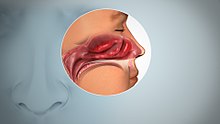
Back فقد الشم Arabic Anosmiya Azerbaijani ঘ্রাণহানি Bengali/Bangla Anosmiezh Breton Anosmija BS Anòsmia Catalan Anosmie Czech Anosmie German Anosmio Esperanto Anosmia Spanish
| Anosmia | |
|---|---|
| Other names | Loss of smell, smell blindness,[1] odor blindness |
 | |
| Inflamed nasal mucosa causing anosmia | |
| Pronunciation | |
| Specialty | Otorhinolaryngology |
| Types | Partial, total[2] |
Anosmia, also known as smell blindness, is the loss of the ability to detect one or more smells.[1][2] Anosmia may be temporary or permanent.[3] It differs from hyposmia, which is a decreased sensitivity to some or all smells.[2]
Anosmia can be categorized into acquired anosmia and congenital anosmia. Acquired anosmia develops later in life due to various causes, such as upper respiratory infections, head trauma, or neurodegenerative diseases.[4] In contrast, congenital anosmia is present from birth and is typically caused by genetic factors or developmental abnormalities of the olfactory system.[5] While acquired anosmia may have potential treatments depending on the underlying cause, such as medications or surgery, congenital anosmia currently has no known cure, and management focuses on safety precautions and coping strategies.[6]
Anosmia can be due to a number of factors, including inflammation of the nasal mucosa, blockage of nasal passages, or destruction of temporal lobular tissue.[7] Anosmia stemming from sinus inflammation is due to chronic mucosal changes in the lining of the paranasal sinus and in the middle and superior turbinates.[8][9]
When anosmia is caused by inflammatory changes in the nasal passageways, it is treated simply by reducing inflammation.[10][11] It can be caused by chronic meningitis and neurosyphilis that would increase intracranial pressure over a long period of time,[12] and, in some cases, by ciliopathy,[13] including ciliopathy due to primary ciliary dyskinesia.[14]
The term derives from the Neo-Latin anosmia, based on Ancient Greek ἀν- (an-) + ὀσμή (osmḗ 'smell'; another related term, hyperosmia, refers to an increased ability to smell). Some people may be anosmic for one particular odor, a condition known as "specific anosmia". The absence of the sense of smell from birth is known as congenital anosmia.[15]
In the United States, 3% of people aged over 40 are affected by anosmia.[3]
Anosmia is a common symptom of COVID-19 and can persist as long COVID.[16]
- ^ a b Coon D, Mitterer J (2014). "4. Sensation and perception". Introduction to Psychology: Gateways to Mind and Behavior. Boston: Cengage Learning. p. 136. ISBN 978-1-305-09187-0. LCCN 2014942026.
- ^ a b c Jones N (2010). "2. Making sense of symptoms". In Jones N (ed.). Practical Rhinology. CRC Press. pp. 24–25. ISBN 978-1-4441-0861-3.
- ^ a b Li X, Lui F (6 July 2020). "Anosmia". StatPearls. StatPearls Publishing. PMID 29489163. Retrieved 1 December 2020.
- ^ Li, X.; Lui, F. (2021). "Anosmia - StatPearls - NCBI Bookshelf". NCBI. PMID 29489163. Retrieved 2024-07-06.
- ^ "Congenital Anosmia". Fifth Sense. Retrieved 2024-07-06.
- ^ "Loss of smell (anosmia) Causes". Mayo Clinic. Retrieved 2024-07-06.
- ^ Huynh PP, Ishii LE, Ishii M (July 2020). "What Is Anosmia?". JAMA. 324 (2): 206. doi:10.1001/jama.2020.10966. PMID 32556300. S2CID 219916772.
- ^ Helliwell T (June 2010). "Inflammatory diseases of the nasal cavities and paranasal sinuses". Diagnostic Histopathology. 16 (6): 255–264. doi:10.1016/j.mpdhp.2010.03.008. PMC 7172334. PMID 32336992.
- ^ Lin YT, Yeh TH (2022). "Studies on Clinical Features, Mechanisms, and Management of Olfactory Dysfunction Secondary to Chronic Rhinosinusitis". Frontiers in Allergy. 3: 835151. doi:10.3389/falgy.2022.835151. PMC 8974686. PMID 35386650.
- ^ Knight A (August 1988). "Anosmia". Lancet. 2 (8609): 512. doi:10.1016/s0140-6736(88)90160-2. PMID 2900434. S2CID 208793859.(subscription required)
- ^ "Sinusitis Clinical Practice Guideline Quick Reference Tools", Pediatric Clinical Practice Guidelines & Policies, American Academy of Pediatrics, pp. 481–484, 2022-04-11, doi:10.1542/9781610026086-part01-27, ISBN 978-1-61002-608-6, retrieved 2023-11-07
- ^ "Anosmia". The Lancet. 241 (6228): 55. 1943. doi:10.1016/S0140-6736(00)89085-6. S2CID 241387103.
- ^ Uytingco CR, Green WW, Martens JR (2019). "Olfactory Loss and Dysfunction in Ciliopathies: Molecular Mechanisms and Potential Therapies". Current Medicinal Chemistry. 26 (17): 3103–3119. doi:10.2174/0929867325666180105102447. PMC 6034980. PMID 29303074.
- ^ Ul Hassan A, Hassan G, Khan SH, Rasool Z, Abida A (January 2009). "Ciliopathy with special emphasis on kartageners syndrome". International Journal of Health Sciences. 3 (1): 65–69. PMC 3068795. PMID 21475513.
- ^ Boesveldt S, Postma EM, Boak D, Welge-Luessen A, Schöpf V, Mainland JD, et al. (September 2017). "Anosmia-A Clinical Review". Chemical Senses. 42 (7): 513–523. doi:10.1093/chemse/bjx025. PMC 5863566. PMID 28531300.
- ^ "Q&A: COVID-19 and loss of smell, taste". Mayo Clinic Health System. Retrieved 2022-02-23.